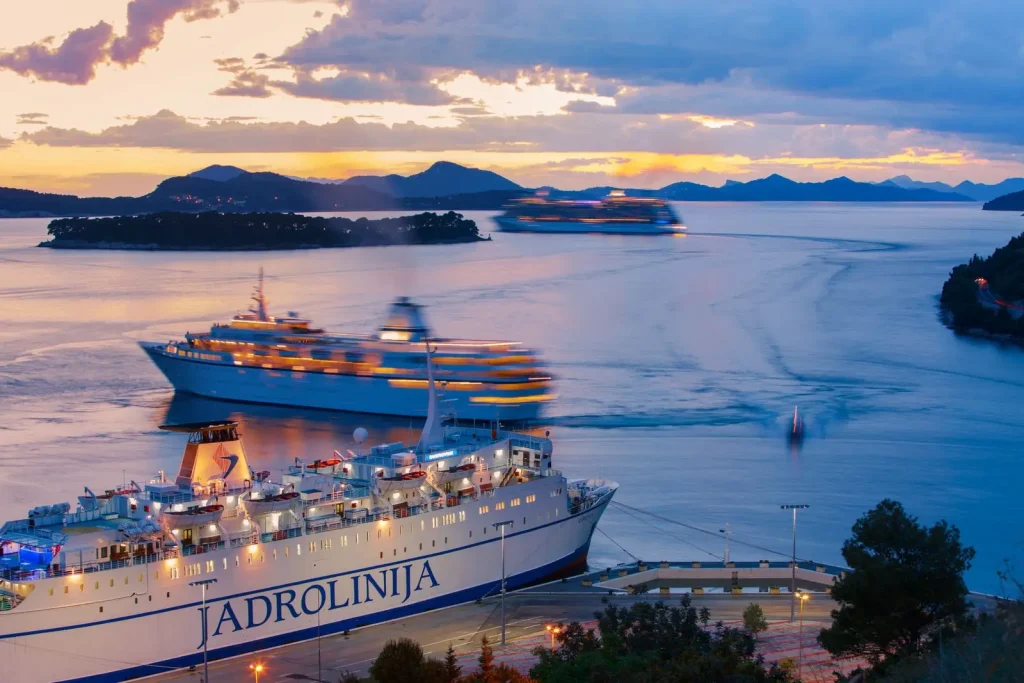As Poslovni Dnevnik/Marija Brnic writes, last week, the well known Croatian ferry Jadrolinija strengthened its fleet with the new ship, Losinj, and according to unofficial announcements, the purchase of another large vessel is now in its final phase, which, according to sources from that shipping company, should be a worthy replacement for the temporary Lastovo ship.
However, in both cases, as in all procurements which have taken place by the book over recent years, these are purchases from the second-hand ship market, which completely deviates from the previously proclaimed policy of rejuvenating the Croatian ferry Jadrolinija’s fleet with new vessels, and the state’s desire as the shipping company’s owner for such projects to also open up opportunities for activating enfeebled Croatian shipyards.
The Losinj ferry, which transports passengers along the Lopar-Valbiska line, was built back in 2010 in Greece and sailed in the area of Greece and the Black Sea until now. With its accession, Jadrolinija’s fleet now numbers 54 ships, and its average age has been slightly improved, to 28.5 years.
The Jadrolinija Management Board hasn’t answered any questions about the procurement of a new ferry that would replace the Lastovo vessel. This case was added to by the fact that the Novo Lastovo project was obtained on two occasions through tenders, for the first time from the Polish company Remontowa Marine Design & Consulting, and a little over a year ago with a new one for a slightly smaller ship, which was designed by the Split-based company Classis.
With all of that being said, it needs to be stated that the Croatian ferry Jadrolinija is not going to be the one to have anything to do with the constrction of Novo Lastovo, for which domestic shipbuilders were very interested at the time. At Poslovni’s request, the company’s management board, headed by David Sopta, provided an interesting explanation as why the purchase of used ships is a better solution for Jadrolinija than buying new ones would be.
“The construction of new ships consists of several long phases and a whole process, from design development to construction, it all takes a minimum of three years. Therefore, the choice to buy used ships is not only more economical, but has a great advantage due to the speed of project implementation and the introduction of those purchased ships into the fleet,” reads the response from the Croatian ferry Jadrolinija, with special emphasis placed on used ships with proven maritime capabilities, and the fact that their procurement ensures operational stability.
They also state that Jadrolinija is always looking for ships of a “younger” age and compliance with all international standards, but also the needs of each respective line.
“If a potential used vessel fits into the defined strategic goals of the company, is economically viable and with its capacity and speed of navigation and can meet all technical, economic and other regulatory requirements, but also ensure increased service quality and the rejuvenation of the fleet, then Jadrolinija decides to invest,” they repeated from Jadrolinija.
The Croatian ferry Jadrolinija’s vessels are otherwise very regularly maintained at annual overhauls at various Croatian shipyards and must pass the very strict controls of the Croatian Shipping Register, but also meet all current international environmental standards. As a confirmation of quality in the company, they stated that they won tenders on the liberalised EU market.
The oldest vessel in operation in their fleet is the motor boat Tiat, built back in 1955 in Brodosplit, sailing on the line Sibenik-Zlarin-Prvic Luka-Sepurine-Vodice. Premuda is a couple of years younger, which sails in the waters of Mali Losinj, followed by Postira from 1963, which sails in the waters surrounding Dubrovnik.
Another old ferry is the already mentioned Lastovo, built in 1969, operating on the line Split-Vela Luka-Ubli. The famous Marco Polo is also considered old for inter-Adriatic traffic on the Split-Ancona line, it was built in 1973, and the youngest ferries were built in 2014 – Brac, Kornati, Krk and Mljet, while the oldest catamaran is Karolina (Vis-Split) from 1989, and the youngest of them, which is also the youngest ship in the entire fleet, is the catamaran Jelena, which connects Lastovo, Korcula, Hvar and Split – it was built in 2018.
The Croatian ferry Jadrolinija doesn’t actually communicate publicly about its procurement plans in this and the coming years. It has recently been announced that despite that, it is in communication with the relevant Ministry of Maritime Affairs, Transport and Infrastructure regarding the preparation of projects that could require applications for access to money from the Recovery and Resilience Fund.
These would be ships requiring renewable energy sources. If they are allocated funds for such projects, they will turn to a greener future in accordance with the strategic direction of the EU.
When asked about these projects, the Croatian ferry Jadrolinija received only a principled position on how to consider and apply for certain EU projects in order to find money for the further development of their fleet, and that in the last couple of years, in cooperation with the relevant ministry, they’ve been looking for ways to prepare and develop EU shipbuilding projects, and that these would exclusively involve ships powered by alternative fuels.
In recent years, Maritime Affair’s Minister Oleg Butkovic has expressed his great dissatisfaction and publicly criticised the policy of procurement of ships practiced by Jadrolinija, and has openly advocated for the construction of new ones. He hasn’t yet commented on the latest purchases of used vessels.
The construction of new ships would also mean the possibility of new jobs in Rijeka, as well as for other shipbuilders, such as Brodosplit, and possibly the new Uljanik 1856, which has been struggling since long before the current coronavirus crisis struck the country.
“Croatian shipyards continuously show that they can build ships that meet customer requirements and they do have the capacity to do so, and we’re convinced that they will apply for a tender for new ships if Jadrolinija decides to announce it,” said Coric.
The Croatian ferry Jadrolinija, on the other hand, still isn’t hiding that the investments it makes in its fleet are based on the purchase of used ships, for which they continuously monitor the situation across the global market.
“Along with fast ships, we want to renew the fleet in the segment of ships for remote islands, ferries for local ‘short lines’, but also to replace the oldest ships in the fleet,” said the company, whose catamarans carry over 900,000 passengers per year.
The pace of this fleet renewal, they added, is dictated by both time and market trends, and on the other hand additional pressure regularly comes from competition that is intensively renewing its fleets.
“We’re on the lookout for the best opportunity on the market to find ships that match the lines maintained by Jadrolinija, including the specifics of our ports and the required capacities on each line,” they said, concluding that due to the pandemic and the dependence of their business on tourism, activities for some new projects remain under consideration only.
For more, follow our business section.








